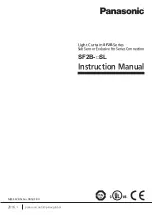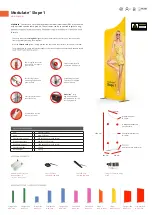
26
VARYSCAN 4 COMPACT PLUS 575 HMI
Unpacking of the Varyscan
®
equipment
Varyscan
®
4 Compact Plus 575 HMI
operating instructions
Check, if the delivery contains all parts.
Should you notice a damage through transportation, please inform immediately the carriers respectively your dealer.
Also in case of noticing missing parts.
Put in/ Exchange of the Bulb
Warning
: Before opening pull out mains plug!
Loosen the screws at the lid of your Varyscan
®
with a suitable screw-driver and lift the lid (label Varyscan
®
4 Compact
Plus 575 HMI). You can see the bulb holder in the back third of your Varyscan
®
(see sketch page 4). Now detach nuts No.1 and No.2 and remove the bulb from
it's holder. Put the new HMI bulb into the holder and tighten nuts No.1 and No.2
by hand. The point on the glass of the bulb should on no account point to the
concave mirror, respectively to the lenses (sketch page 4), it should point to
the base sheet or to the lid. Take care that the bulb is tightened in the holder.
Warning
:
Never
touch the glass of bulb of the 575 HMI bulb itself !
An adjustment of the bulb is not necessary.
Mounting of Mirror
Take the mirror with the metalsheet, put it on the y-motor and close the screws.
Starting the Equipment
1. Hang up of Varyscan
®
To scoop the optimal functioning of your Varyscan
®
, you should hang up the spots as high as possible.
2. Adjustment of Varyscan
®
All spots should hang in the same angle, i.e. the imagined angle between perpendicular and Varyscan
®
should be the
same among all Varyscans*.
3. Cabling of Varyscan
®
Power supply:
A specialist should attach a plug to the open end of the connecting cable, or have the cable connected to 230 Volt 50
Hertz.
DMX-cabling:
Connect the output of your DMX-controller with the first Varyscan
®
(controller DMX-out; Varyscan
®
DMX-in) with the
aid of a 5pole XLR-cabel. Now establish the connection between the Varyscans
®
with the aid of further 5pole XLR-
cables. Make sure that in DMX-out of the last Varyscan
®
there is a resistor (XLR-plug with a resistance of 100 Ohm
between pin 2 and pin 3) plugged into.
4. Adjustment at DIP-switches
At DIP-switch No.1 and No.2 you have the following possibilities of adjustment:





































